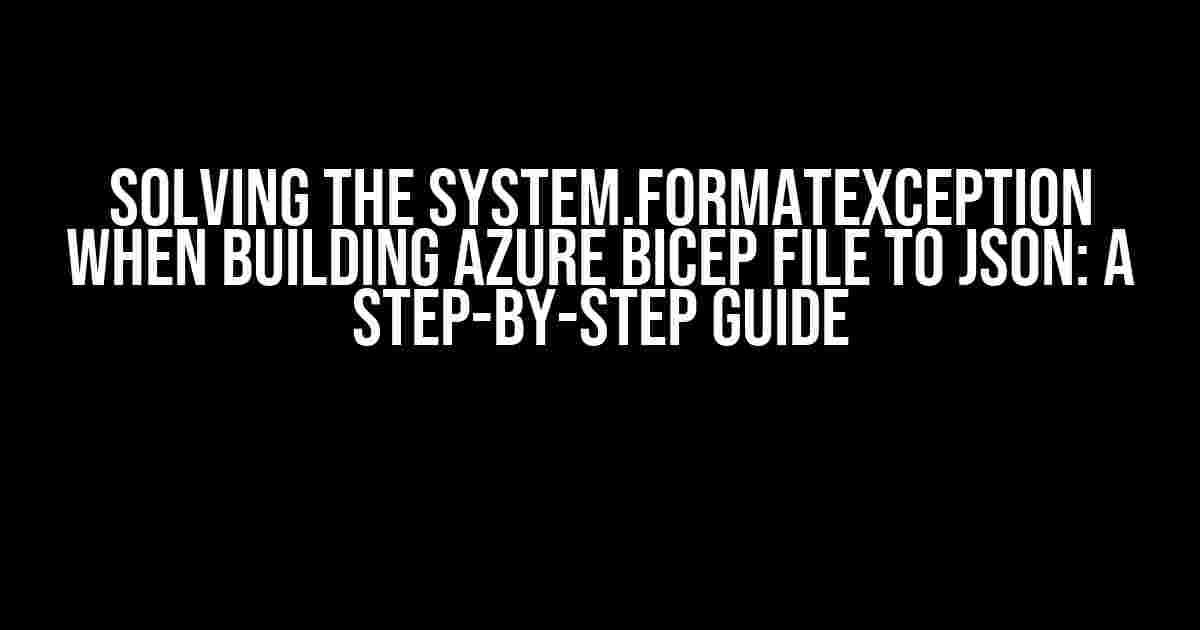Are you tired of encountering the frustrating System.FormatException when building your Azure Bicep file to JSON? You’re not alone! This error can be a real roadblock in your Azure deployment journey. Fear not, dear reader, for we’ve got you covered. In this comprehensive guide, we’ll delve into the causes of this error and provide you with clear, actionable steps to resolve it once and for all.
What is a System.FormatException?
A System.FormatException is a type of exception that occurs when the .NET runtime encounters an issue with the format of a string or an object. In the context of Azure Bicep, this error typically arises when there’s a problem with the JSON output generated by the Bicep compiler.
Causes of System.FormatException in Azure Bicep
Before we dive into the solution, let’s explore the common causes of this error:
- Invalid Bicep syntax: Typos, missing brackets, or incorrect indentation in your Bicep file can lead to a System.FormatException.
- Incorrect data types: Using the wrong data type for a parameter or variable can cause the Bicep compiler to throw this error.
- Circular dependencies: When there are circular dependencies in your Bicep module, it can result in a System.FormatException.
- Version conflicts: Using incompatible versions of the Bicep compiler or Azure SDK can cause this error.
Step-by-Step Solution
Now that we’ve covered the causes, let’s get to the good stuff – solving the System.FormatException! Follow these steps to resolve the error:
Step 1: Validate Your Bicep File
Before building your Bicep file to JSON, ensure that it’s syntactically correct. You can use the Bicep linter tool to identify any syntax errors:
bicep linter yourfile.bicepIf you find any errors, fix them and re-run the linter tool until it returns no errors.
Step 2: Check Data Types
Verify that you’re using the correct data types for your parameters and variables. Refer to the Azure Bicep documentation for the supported data types:
| Data Type | Description |
|---|---|
| string | A sequence of characters |
| int | A 32-bit integer |
| bool | A boolean value (true or false) |
| array | A collection of values |
| object | A collection of key-value pairs |
Step 3: Resolve Circular Dependencies
If you’ve identified circular dependencies in your Bicep module, refactor your code to remove them. You can use the Bicep dependency graph tool to visualize your dependencies:
bicep dependency-graph yourfile.bicepIdentify the circular dependencies and refactor your code to break the cycle.
Step 4: Check for Version Conflicts
Verify that you’re using compatible versions of the Bicep compiler and Azure SDK. You can check the versions using the following commands:
bicep --versionaz --versionEnsure that you’re using the latest versions of both the Bicep compiler and Azure SDK.
Step 5: Build Your Bicep File to JSON
Once you’ve resolved the above issues, you can rebuild your Bicep file to JSON using the following command:
bicep build yourfile.bicep --stdoutIf everything is correct, you should see the JSON output without any errors.
Common Scenarios and Solutions
In this section, we’ll cover some common scenarios where the System.FormatException occurs and provide solutions:
Scenario 1: Missing Bracket in Bicep File
If you’re missing a bracket in your Bicep file, you’ll encounter a System.FormatException. For example:
resource vm 'Microsoft.Compute/virtualMachines@2020-06-01' = {
name: 'myVM'
location: 'eastus'
tags: {
environment: 'dev'
}
// Missing } here
Solution: Add the missing bracket to complete the resource declaration.
Scenario 2: Incorrect Data Type
If you’re using an incorrect data type for a parameter or variable, you’ll encounter a System.FormatException. For example:
param myString string = 123Solution: Correct the data type to match the expected value. In this case, change the data type to `int`:
param myInt int = 123Scenario 3: Circular Dependency
If you have a circular dependency in your Bicep module, you’ll encounter a System.FormatException. For example:
module myModule {
var a = b
var b = a
}Solution: Refactor your code to remove the circular dependency.
Conclusion
In this comprehensive guide, we’ve covered the causes of the System.FormatException when building Azure Bicep files to JSON and provided step-by-step instructions to resolve the error. By following these steps and scenarios, you should be able to overcome this frustrating error and successfully deploy your Azure resources using Bicep.
Remember to validate your Bicep file, check data types, resolve circular dependencies, and ensure compatible versions of the Bicep compiler and Azure SDK. With these tips and tricks, you’ll be well on your way to becoming a Bicep master!
Frequently Asked Question
Got stuck while building an Azure Bicep file to JSON? Worry not, we’ve got you covered! Here are some frequently asked questions and answers to help you troubleshoot the “System.FormatException” error.
What causes the System.FormatException when building an Azure Bicep file to JSON?
The System.FormatException typically occurs when there’s an error in the Bicep file syntax, such as incorrect indentation, mismatched brackets, or invalid property names. This can prevent the Bicep compiler from correctly converting the file to JSON.
How do I troubleshoot the System.FormatException error in my Azure Bicep file?
To troubleshoot the error, review your Bicep file line by line, paying close attention to syntax and formatting. You can also use the Bicep CLI command `bicep build –verbose` to get more detailed error messages.
What are some common Bicep file syntax errors that can cause the System.FormatException?
Common syntax errors include incorrect indentation, missing or mismatched brackets, invalid property names, and incorrect use of keywords like `resource` or `var`.
Can I use Visual Studio Code extensions to help me identify Bicep file syntax errors?
Yes, you can! Visual Studio Code has several extensions available, such as the Azure Bicep extension, that provide syntax highlighting, IntelliSense, and error detection to help you catch syntax errors and prevent the System.FormatException.
What are some best practices to avoid System.FormatException errors when building Azure Bicep files to JSON?
Best practices include following the official Azure Bicep syntax guidelines, using consistent indentation and formatting, and regularly validating your Bicep file syntax using the Bicep CLI or Visual Studio Code extensions.




